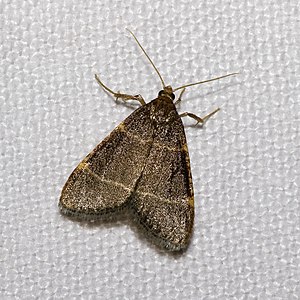Hypsopygia glaucinalis
| Hypsopygia glaucinalis | ||||||||||||
|---|---|---|---|---|---|---|---|---|---|---|---|---|

Hypsopypia glaucinalis |
||||||||||||
| Systematics | ||||||||||||
|
||||||||||||
| Scientific name | ||||||||||||
| Hypsopygia glaucinalis | ||||||||||||
| ( Linnaeus , 1758) |
Hypsopygia glaucinalis is a ( small ) butterfly from the family of the common borer (Pyralidae) and belongs to their subfamily Pyralinae .
features
The wingspan of the moth is 20 to 32 mm (23 to 30 millimeters or a forewing length of 11 to 13 mm). The forewings of Hypsopygia glaucinalis are dark brown with two light, thin transverse lines each. These are slightly thickened at the front edge. The outer transverse line is also slightly curved in the middle. The hind wings are noticeably lighter, but also have two white transverse lines that follow one another more closely. The antennae of the males are short and ciliate, the antennae of the females are simple and thread-shaped.
The caterpillar is blackish brown with a rusty yellow head and neck shield (or black head).
Geographical distribution and habitat
The distribution area of the species extends over almost all of Europe, North Africa, Asia Minor, Northern Iran to the Russian Far East, Sakhalin, Kuril Islands, Northern China, the Korean Peninsula and Japan. In northern China the species rises up to 2250 m above sea level.
The species occurs in landscapes rich in forests and bushes, but also synanthropically in hay stalls and thatched buildings.
Way of life
Hypsopygia glaucinalis forms one generation per year in Central Europe; the moths fly from June to September. Several generations are formed in warmer regions. The moths are crepuscular and nocturnal and come to artificial light sources. Occasionally they also fly during the day, mostly they rest hidden in haystacks, gazebos, straw huts and under dry leaves. They often sit with their wings outstretched and abdomen arched up. The caterpillars can be found from September. They live socially in a tube-like web and also hibernate in it. They feed on dead plant material such as hay, fallen leaves, and can also be found in bird nests. Pupation takes place in a light cocoon in the food material.
Parasitoids
The caterpillar fly Mintho rufiventris is a parasitoid of the butterfly species .
Taxonomy
The taxon was first scientifically described by Carl von Linné in 1758 as Phalaena (Pyralis) glaucinalis . With "Pyralis" nitidalis Fabricius, 1794 and Pyralis yokohamae Butler, 1879 there are two other synonyms. For a long time it was uncertain which genre it belonged to; the species therefore appears in the literature in the combinations Herculia glaucinalis , Ocrasa glaucinalis , Orthopypia glaucinalis and, since 2006, under Hypsopygia glaucinalis .
swell
Individual evidence
- ↑ Slamka (2006: p. 36/7) (as Hypsopygia (Ocrasa) glaucinalis )
- ↑ UK moths - website of Ian Kimber (as Orthopygia glaucinalis )
- ↑ a b Hannemann (1964: p. 248) (as Herculia glaucinalis )
- ↑ Eckstein (1933: p. 61) (as Herculia glaucinalis )
- ^ Chinese academy of sciences: Insects of the Hengduan mountains region. The comprehensive Scientific Expedition to the Qinghai-Xizang Plateau / Chinese Academy of Sciences. Beijing, Science Press, 1992.
- ^ Carl von Linné: Systema naturæ per regna tria naturæ, secundum classes, ordines, genera, species, cum characteribus, differentiis, synonymis, locis. 10th edition, Stockholm 1758 Online at SUB Göttingen (description of the species p. 533)
- ↑ a b GlobIZ
literature
- Karl Eckstein: The butterflies of Germany 5th volume The small butterflies of Germany . 222 p., KG Lutz Verlag, Stuttgart 1933
- Hans-Joachim Hannemann: Small butterflies or Microlepidoptera II. The moths (sl) (Cochylidae and Carposinidae) The moths (Pyraloidea). In: Friedrich Dahl: The animal world of Germany and the adjacent parts of the sea according to their characteristics and their way of life. Part 50, VEB Gustav Fischer Verlag Jena 1964
- Ivar Hasenfuss: The Larval systematics of the bulls (Pyralidae). 263 pp., Akademie-Verlag, Berlin 1960.
- Frantisek Slamka: Pyraloidea of Europe / Europa (Lepidoptera) Volume 1 Pyralinae, Galleriinae, Epipaschiinae, Cathariinae & Odontiinae. 138 pp., Bratislava 2006, ISBN 80-969052-3-6
- Patrice Leraut: Contribution à l'étude du genre Hypsopygia Hübner (Lepidoptera, Pyralidae). Revue française d'Entomologie (NS), 28 (1): 5-30, Paris
Web links
- www.lepiforum.de Taxonomy and photos
- Moths and Butterflies of Europe and North Africa (English)
- Ian Kimber: Guide to the moths of Great Britain and Ireland (as Orthopygia glaucinalis )
- Moths and Butterflies of Europe and North Africa (English)
- Chris Jonko's website
- Hypsopygia glaucinalis in Fauna Europaea
